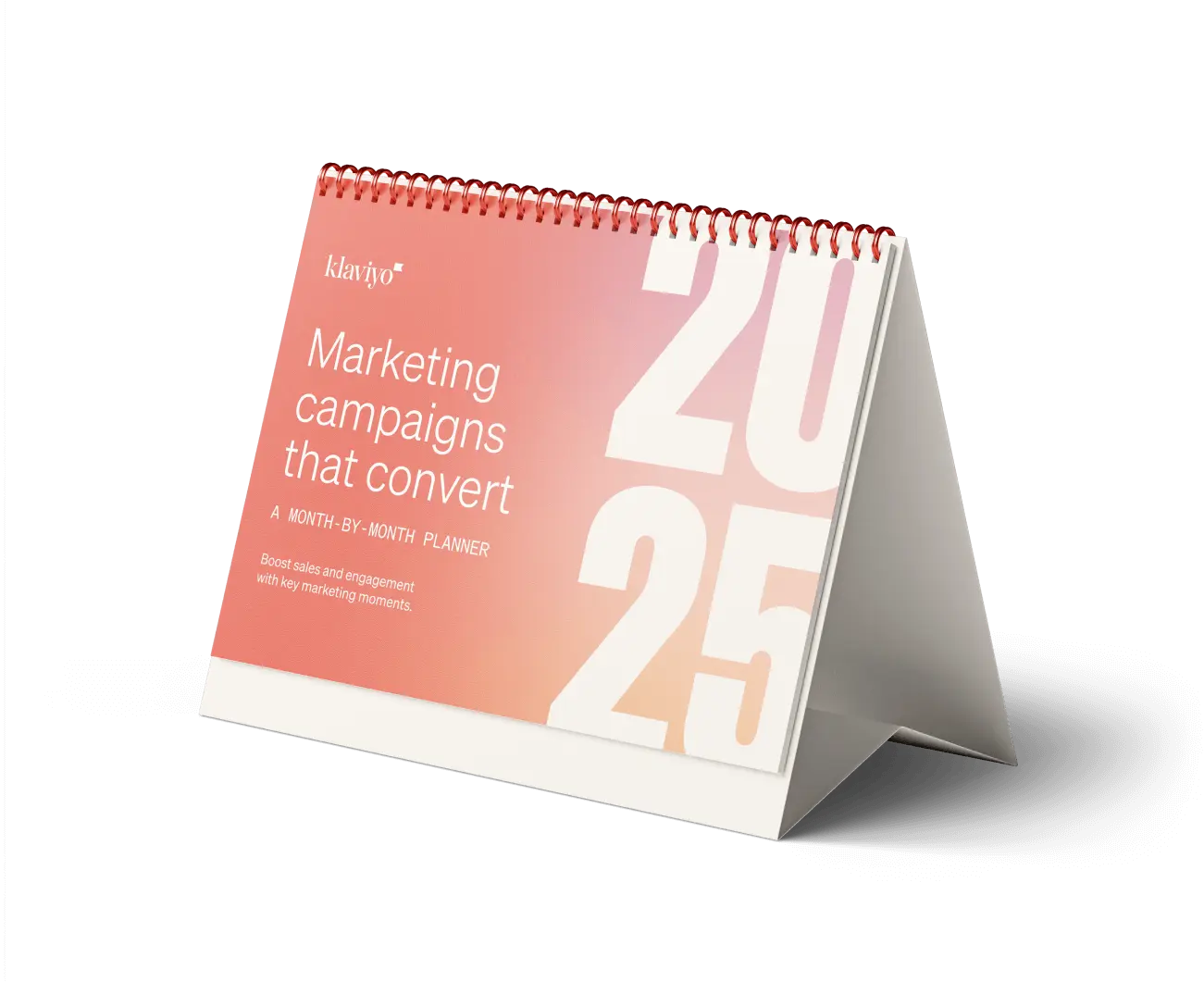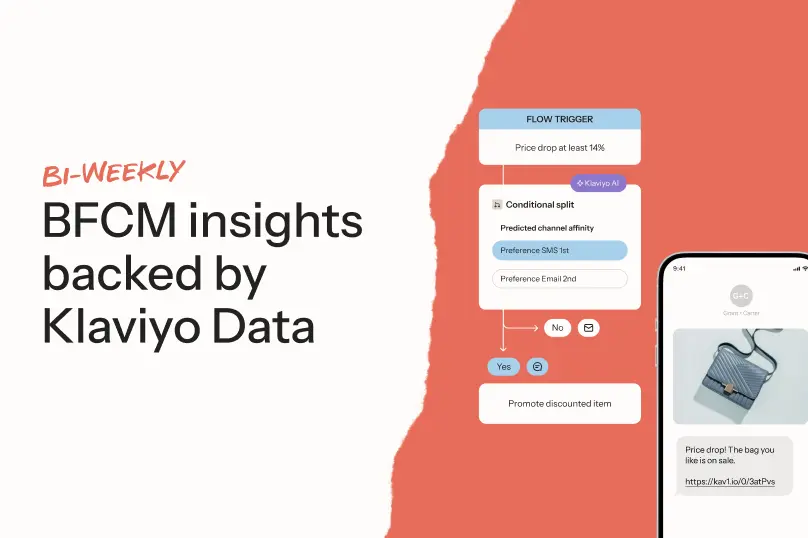7 Hanukkah marketing ideas for a festive holiday season

Hanukkah, the Festival of Lights, is a Jewish celebration of resilience and tradition. Rooted in a miracle in which oil lit a lamp for 8 days even though it was only enough for one, it’s a time for family gatherings, lighting the menorah, and indulging in treats like sufganiyot and latkes.
Gift-giving is a more recent addition to Hanukkah traditions, but the holiday is about much more than presents. Hanukkah is an opportunity for ecommerce brands to engage with customers in a way that honors these traditions while also providing unique value.
Whether it’s highlighting exclusive products, offering a Hanukkah-themed gift guide, or creating campaigns centered around family, tradition, and the spirit of the season, there are plenty of ways to show your customers that your brand understands and respects the essence of Hanukkah.
While we can’t promise you’ll become a part of your customers’ holiday traditions like sufganiyot, we can present you with 7 Hanukkah marketing ideas—one for each candle on the menorah.

1. Gather customer data with quizzes
Quizzes are not only fun, but also a perfect way to engage your audience during Hanukkah while collecting valuable customer data to use in future marketing efforts.
An integrated customer data infrastructure is the backbone of almost every memorable marketing and service interaction you’ve experienced over the last few years. The more you can get to know your customers, the better you can serve them with:
- Relevant promotions that reduce message fatigue: People receive too many messages in a day to pay attention to what’s not relevant to them. Granular customer data that reflects real brand interactions is the single most important tool for increasing conversions on your promotions.
- Personalized customer service across all channels: Customer data serves your support teams just as much as it does marketing. For example, when a service agent can see that a customer has dry skin from the results of a quiz, they’re in a better position to answer questions and make personalized suggestions. This is how smaller brands are able to compete with larger ones on service.
- Self-service that keeps customers engaged: According to Microsoft, 90% of consumers expect self-service support options. When that self-service is personalized with, for example, educational content that’s attached to wishlisted items, you’re keeping customers engaged by serving them better than your competitors.
Quizzes are one of the best ways to collect psychographic data that goes beyond demographics to serve customers based on their lifestyle, values, pain points, and goals. When you collect data with quizzes, you’re asking people to get specific about the kinds of products they’ll buy—and how ready they are to buy them.
For Hanukkah, you may want to design a quiz that gathers holiday-related lifestyle data. If you run a food and beverage brand, for example, ask people about their ideal Hanukkah spread. If you sell home and decor products, ask customers to build their scent profile for their ideal candle.
Quiz example: Andie Swim drives revenue with their fit-finder quiz
If you’re not familiar with the power of quizzes in ecommerce marketing, look no further than Andie Swim. The swimwear brand uses a fit-finder quiz to segment their email list based on style and fit preferences—a strategy that drove over $70,000 in revenue in just 8 months.
Hanukkah marketing tip: When customer service teams have access to quiz results such as style and fit within a B2C CRM, they’re in a better position to make fast and informed corrections during support interactions.
2. Grow your subscriber lists with a contest or giveaway
People love gifts and freebies, so a well-executed contest or giveaway can be another powerful way to grow your subscriber lists before Hanukkah.
Instead of offering a universal discount in exchange for sign-ups, it’s worth experimenting with the chance to win a contest as a unique holiday incentive. Other non-discount incentives to consider include free gifts with purchase, free shipping when customers spend above a certain threshold, and early-bird deals.
Consider your channel goals here, too. According to Klaviyo’s 2025 online shopping report, 77% of omnichannel consumers shop across 3–4 channels. That means channel diversity among subscribers is a strength—and the holidays are a great time to foster it.
Let’s say you have a large email list but virtually zero text message subscribers. You may want to run an email-only holiday contest that enters subscribers in a chance to win in exchange for a phone number. You can run similar contests to gain WhatsApp subscribers, mobile app downloads, and social media follows.
Eventually, when you’re able to reach subscribers across multiple channels, you’ll be able to send them more relevant messages on the channels they most prefer.
This is important for reducing message fatigue and increasing engagement. When someone consistently ignores email but engages on WhatsApp, for example, you’ll want to reach out with promotions on WhatsApp first.
Contest marketing example: POPFLEX encourages holiday wishlisting
In the spirit of Hanukkah, you might offer contest entrants the chance to win a one-time donation in their name to a charity of their choice in exchange for their contact information. Or, you can take a leaf out of POPFLEX’s book and run a giveaway that offers participants the chance to win a free shopping spree.
The activewear brand took this approach before the 2023 holiday season. To enter, contestants had to create a holiday wishlist on the POPFLEX website. Nearly 100,000 people ended up entering the contest, supplying the brand with valuable data for personalizing communications with subscribers over the course of the holiday season—all of which contributed to 91% YoY growth in ecomm revenue.
Hanukkah marketing tip: To set up the ideal environment for wishlisting, consider creating a personalized on-site experience for your customers. When customers can sign into a customer hub on your website, they can easily create Hanukkah wishlists for the many gifts they’d like to purchase over the holiday.
3. Create a Hanukkah-themed product
Creating a Hanukkah-themed product is a powerful way to connect with your audience during the season. By developing something unique that resonates with the holiday’s traditions and symbology, you can do more than just meet market demand—you can also earn trust with your audience.
Plus, the data you gather from holiday-specific campaigns like this creates a win-win situation. Segments of customers who buy from holiday-specific campaigns may be more likely to convert on similar campaigns in the future. When people click or buy products created for a specific purpose, you’re generating customer data that can produce more relevant offers down the line.
Hanukkah marketing example: Little Sleepies creates Hanukkah-themed pajamas
Take Little Sleepies as an example. They make soft, comfortable sleepwear for children and adults. They also do marketing right.
To boost Hanukkah sales and connect with their audience, Little Sleepies introduced Hanukkah-themed pajamas featuring menorahs, dreidels, and Stars of David. And the product line wasn’t just for kids. The brand also unveiled adult sleepwear featuring the same motifs so the entire family could look picture-perfect when it came time to snap a holiday photo.

4. Share traditional Hanukkah recipes
Food plays a special role in Hanukkah celebrations, making it a great theme to weave into your Hanukkah marketing. Dishes like latkes and sufganiyot aren’t just delicious—they’re a nod to the miracle of Hanukkah, when, remember, a small amount of oil lasted 8 days.
Depending on what your brand sells and who you’re marketing to, sharing traditional recipes like latkes, sufganiyot, or brisket through emails or text messages could be a smart Hanukkah marketing strategy.
Hanukkah email marketing example: Boarderie shares a time-saving meal
A great example is Boarderie, a brand that makes artisan cheese and charcuterie boards for all occasions—including Hanukkah. A quick glance at Boarderie’s email campaign makes it obvious they’re offering tasty food and a convenient solution for those without time to prepare a feast.

But Boarderie is also doing several other things right with this Hanukkah marketing email. Notice how it contains:
- A catchy headline with a playful twist on the holiday tradition
- Excellent product positioning right at the top
- Bold, hard-to-miss CTAs, with contrasting colors and inviting copy
- A bestseller section for cross- and up-selling
Hanukkah marketing tip: One way to improve an email like this would be through personalized product suggestions. Now, with AI, brands can create dynamic content blocks that populate based on a customer’s last purchase.
In this case, the “2-cheese double cream baked brie board” may be a bestseller—but it’s not necessarily something the recipient wants. In fact, their last purchase may have been Boarderie’s “football medium cheese and charcuterie board,” signaling they’re more likely to buy something fit for a larger family.
5. Collect Hanukkah-themed reviews for next year
According to Klaviyo’s 2025 future of consumer marketing report, reviews are the most influential factor for customers when making a first purchase.
Of course, reviews need to be detailed and plentiful to influence purchase decisions. When customers land on your product pages, they want to see reviews that address their specific pain points at length and with photos.
For Hanukkah, you may want to get ahead of customer expectations by including holiday-themed reviews in your marketing messages. Depending on your industry, these reviews could include festive images of a holiday spread or detailed descriptions of the joy of receiving a gift.
To collect these kinds of reviews for next year, build a review request flow timed to product usage. You may also want to offer an incentive for reviews that contain images, like Compass Coffee did when they boosted these review types 3.7x in one quarter.
Hanukkah email marketing example: Sloomoo Institute increases image-based UGC with an incentive
One great example of this is Sloomoo Institute, an interactive, experiential space that calls itself “a celebration of sensory play,” which embraced the Hanukkah spirit by creating themed slime kits.
Sloomoo Institute developed slimes in traditional holiday colors, like blue and silver, and infused them with sparkles, charms, and even scents reminiscent of holiday treats. They even added a little twist to their “Got Gelt” slime, inspired by the traditional Hanukkah gift gelt: a real or chocolate coin wrapped in gold foil.

But here’s where the marketing gets really brilliant: the email encourages those lucky enough to receive the “Got Gelt” slime with real gelt inside to snap a photo, share it on their socials, and get another slime for free. It’s a great way to center user-generated content (UGC) and raise authentic brand awareness during the 8-day celebratory period.
6. Share holiday wishlist ideas for every day of Hanukkah
The 8 days of Hanukkah present many opportunities for gift guides and wishlisting.
A few weeks ahead of the holiday, consider running gift guide campaigns with call-to-action buttons that encourage wishlisting. Similar to POPFLEX’s aforementioned contest, gift guides that nudge people toward creating an account on your website are great ways to strengthen customer relationships.
Here are a few ideas for taking this gift-a-day approach with your audience:
- Share a one-time gift guide that includes 8 different products, one for each night of Hanukkah.
- Create an 8-part email or text message sequence that sends one gift idea per day in the weeks leading up to the holiday, making it easy for your customers to wishlist the item through their customer hubs.
- Develop an 8-item bundle under a single price tag that’s slightly lower than it would be if customers bought each item individually. It’s a win-win for customers: savings alongside the convenience of making a single purchase.
Hanukkah email marketing example: United By Blue keeps engagement high with a gift bundle
In this example, sustainable clothing brand United By Blue shares a straightforward gift guide with products that “go together like latkes, sour cream, and applesauce.” It’s a smart way to feature a range of items that cater to different tastes, keeping customers engaged over the multi-day holiday. sustainable clothing brand United By Blue takes the first approach, sharing a straightforward gift guide with products that “go together like latkes, sour cream, and applesauce.” It’s a smart way to feature a range of items that cater to different tastes, keeping customers engaged over the multi-day holiday.

7. Demonstrate the principle of tzedakah
One principle of Jewish tradition is tzedakah, which translates to “righteousness” or “justice” but which is commonly used to refer to acts of charity.
Living by this tenet will make you feel good—we all know that. What it can also do is help improve your brand’s reputation. Engaging in acts of charity can help your brand generate positive publicity and form deep and meaningful connections with your audience.
Here are a few ideas for how to implement this strategy around Hanukkah:
- Find a reliable local charity and make a donation.
- Organize a food or toy drive to help those in need.
- Donate a percentage of your sales around Hanukkah to one or more families or charities.
- Organize a fundraising event for a cause near and dear to your heart.
- Sponsor a project to help the local community.
Whichever way you decide to help, share your good deed across multiple channels. This will create a positive image of your brand and cater to customers who enjoy buying from and supporting a business that gives back to the community.
To make an even greater impact, invite your audience to do charity work themselves in any way they can—whether through financial donations or helping out at an organization. In return, you can give back to your customers by offering a discount to those who give back this holiday season. That way, everyone benefits from paying it forward.
Holiday email marketing example: London Sock Co. leans in to tzedakah with a typo
One holiday season, London Sock Co. not only offered their customers a discount for the entire month of November, but also pledged to donate two pairs of socks to a homeless charity for every purchase their customers made.
When one of their emails spreading the word about the initiative contained a typo promising to donate 22 pairs of socks instead of two, London Sock Co. proved their integrity by donating 22 pairs per purchase for the entire remainder of the month.
All of this contributed to a 142% increase in revenue during Black Friday, which only goes to show you that no good deed goes unnoticed.
Send more relevant Hanukkah messages with Klaviyo B2C CRM
No matter the holiday, a large part of your revenue is determined by how well you can personalize your campaigns year-round—and that means centralizing customer data, segmenting those profiles, and sending offers that are relevant to them.
Klaviyo B2C CRM makes it easy for brands to collect the zero- and first-party data they need to deliver personalized experiences for their customers. As a data platform with marketing automation, customer service, and analytics under one roof, Klaviyo B2C CRM is making it possible for brands to scale personalization for thousands or even millions of customers.

Related content

Learn 5 ways to turn new holiday shoppers into repeat buyers using personalization, seamless returns, targeted outreach, and AI-driven customer experiences.

Learn what to include in your photography style guide to create consistent, on-brand visuals across your B2C marketing channels.

Shopping is about to hit its peak season. But this year’s surge will look different from those before it. Instead of impulsive buying sprees, shoppers are entering the holidays with a more deliberate mindset.
